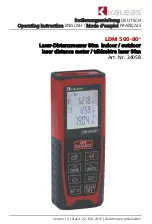
9
Pitot Probe
Step 1: Remove sensing port caps.
Step 2: Connect two hoses (C) to sensing ports (B).
Step 3: Select proper Range Selector (D).
Note: For velocities below 2500 feet per minute, use the Range Se-
lector with black letters; for velocities above 2500 feet per minute,
use the Range Selector with red letters.
Step 4: Connect the hoses to the Range Selector (D) as follows: The plus
(+) sensing port of the meter to the plus (+) sensing port of the Range
Selector and the minus (–) sensing port of the meter to the minus (–) sens-
ing port of the Range Selector.
Step 5: Insert the Pitot Probe (E) into the Range Selector (D). Push the
Pitot Probe firmly down until the collar of the probe rests against the top
of the Range Selector.
Step 6: Check position of switch button (Da) on Range Selector (D). It
must be released and left in the out position.
Step 7: Check position of switch plate (Db) on Range Selector (D). It must
be positioned for the proper velocity range.
Step 8: Proceed to make necessary duct velocity measurements. See page
13 for proper procedures.
Lo-Flow Probe
Step 1: Remove sensing port caps.
Step 2: Connect the Lo-Flow
Probe (F) directly to the meter (A)
by placing it onto the sensing ports
(B); no hoses are required. It fits
only one way onto the meter, with
the arrow pointing to the left when
viewing the meter from the front.
Db
Switch
Plate
Da
Switch
Button
Range
Selector
D
C
Hoses
A
Meter
B
Sensing
Ports
E
Pitot
Probe
Lo-Flow Probe
F









































